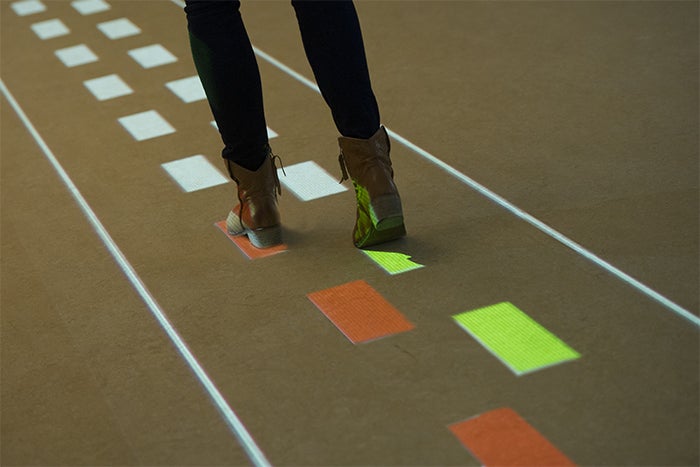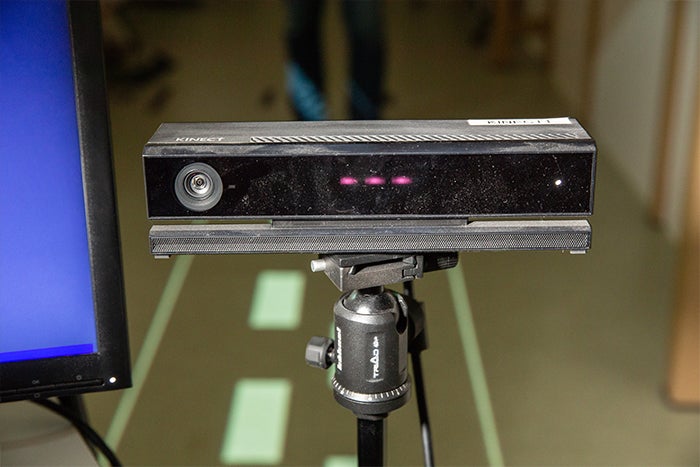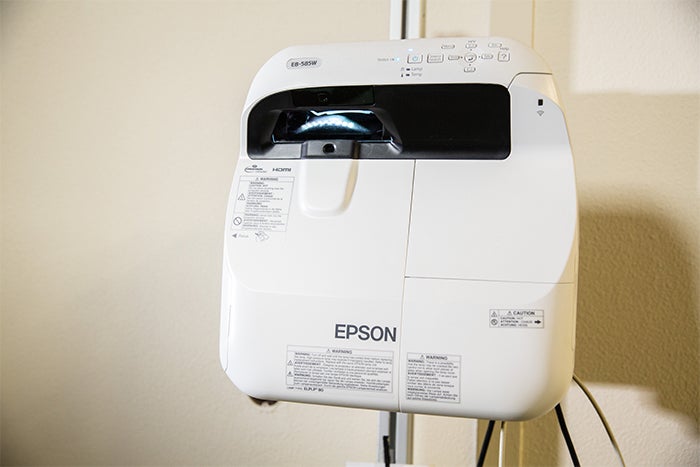Interactive Walkway
Instrumented augmented-reality walkwayInteractive Walkway
The Interactive Walkway, an instrumented augmented-reality walkway, is a validated experimental setup intended for use in scientific research on walking. It uses multiple spatially and temporally integrated Microsoft Kinect sensors for 3D full-body motion registration, without having to attach markers or sensors to the body. A short-throw projector is used to augment the walking surface with movement-dependent visual context, such as obstacles or stepping targets. The Interactive Walkway can be used for a validated quantitative gait assessment, but also allows for a broad repertoire of higher-order walking-ability assessments, including standardized evaluations of one’s ability to suddenly stop walking, to avoid obstacles, to veer or turn and to rapidly change walking speed.
Features
- Validated markerless full-body 3D kinematics of walking along a 10m walkway, based on Kinect technology [Geerse et al. 2015•
- Walkway with projector-generated targets and obstacles, which can appear suddenly in a movement-dependent manner (e.g., obstacle appearing at midswing at the next foot placement location)
- Standardized and customizable assessments of gait and walking adaptability (a.o. obstacle avoidance, stopping, turning, precision stepping, dual-tasking, slaloming) [Geerse et al. 2017a, 2019a]
- Validated outcome measures of gait and walking-adaptability [Geerse et al. 2017a, 2018]
- Quick assessment of targeted risk factors for walking-related falls [Geerse et al. 2019]
- Developed with and for scientists




Specifications
- Multiple spatially and temporally integrated Kinect v2 sensors (default 4), including computers and LAN communication
- Short throw projector for augmenting the entire 10m walkway
- Data acquisition software (sampling rate 30 Hz)
- Calibration map
- Manual
Credentials
The Interactive Walkway is developed by engineers and scientists of the Department of Human Movement Sciences of Vrije Universiteit Amsterdam. It is currently used for research on gait and walking adaptability at the Department of Human Movement Sciences of Vrije Universiteit Amsterdam, the Technology in Motion lab of the Department of Neurology of Leiden University Medical Center and the Clinical Gait Lab of Amsterdam Rehabilitation Research Center | Reade. Furthermore, the Centre for Health Sciences Research of the University of Salford, Manchester, UK, uses its projection system.
The main network of scientific collaboration is maintained by Melvyn Roerdink, assistant professor Technology in Motion at the Department of Human Movement Sciences of Vrije Universiteit Amsterdam. Read his credential.
References/related publications
Selected scientific papers providing technical validation of the Interactive Walkway in terms of its markerless full-body kinematics and derived outcome measures:
- Geerse DJ, Coolen BH, Roerdink M (2015). Kinematic Validation of a Multi-Kinect v2 Instrumented 10-Meter Walkway for Quantitative Gait Assessments. PLoS One 10: e0139913.
- Geerse DJ, Coolen BH, Roerdink M (2017a). Walking-adaptability assessments with the Interactive Walkway: Between-systems agreement and sensitivity to task and subject variations. Gait Posture 54: 194-201.
- Geerse D, Coolen B, Kolijn D, Roerdink M (2017b). Validation of Foot Placement Locations from Ankle Data of a Kinect v2 Sensor. Sensors (Basel); 17: 2301.
- Selected scientific papers providing scientific validation for the use of the Interactive Walkway for assessing unconstrained walking, dual-task walking, walking adaptability and fall risk:
- Geerse DJ, Roerdink M, Marinus J, van Hilten JJ (2018). Assessing Walking Adaptability in Parkinson's Disease: “The Interactive Walkway”. Frontiers in Neurology 9: 1096.
- Timmermans C, Roerdink M, Kerste M, Meskers CG, Janssen TWJ, Beek PJ (2016). Walking adaptability therapy after stroke: study protocol for a randomized controlled trial. Trials, 17: 425.
- Timmermans C, Roerdink M, Janssen TWJ, Meskers CGM, Beek PJ (2018). Dual-Task Walking in Challenging Environments in People with Stroke: Cognitive-Motor Interference and Task Prioritization. Stroke Research and Treatment 2018: 7928597. e DJ, Roerdink M, Marinus J, van Hilten JJ (2019). Walking adaptability for targeted fall-risk assessments. Gait Posture (in press)
PhD Thesis with the Interactive Walkway
- Daphne Geerse (2019, in press). A comprehensive approach to assess walking ability and fall risk using the Interactive Walkway. LUMC
- Celine Timmermans (2019, in press). Walking-adaptability assessment and training: steps towards clinical implementation. VU.
More information
Interactive Walkway Scientific Development Team
Daphne Geerse E : d.j.geerse@vu.nl
Celine Timmermans E: c.timmermans@reade.nl
Bert Coolen E: h.coolen@vu.nl
Melvyn Roerdink E: m.roerdink@vu.nl
